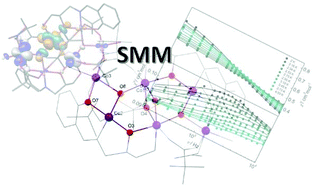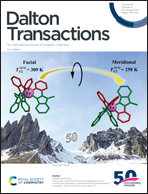Anisotropic exchange interaction and field-induced SMM behaviour in a mixed valence {Co II4Co III2} complex†
Abstract
We are reporting the synthesis and structural characterization of a new hexanuclear Co(II)/Co(III) complex starting from a versatile pivalate cobalt precursor and the racemic mixture of a chelating Schiff base type ligand. The main [CoII4CoIII2(μ3-OH)2(μ-OR)2(μ-OR′)2(μ-OR′′)2]6+ core is unprecedented and exhibits an inversion center that affords only two unique Co(II) sites. We performed DC and AC magnetic measurements and analysed them in terms of the anisotropic exchange of ground Kramers doublets at each Co(II) site due to their unquenched angular orbital contribution to the magnetic moment. Quantum computations support the experimental data treatment. The interplay of dominant antiferromagnetic exchange, inversion symmetry and a non-collinear main quantization axis affords an exchange energy spectrum with mostly non-magnetic states. Nevertheless, field induced SMM behaviour is observed at 1500 Oe and below 3 K which might be explained by the relaxation of the first excited magnetic state (which is populated enough) through the next closest excited state. The Orbach and/or Raman mechanism could be operative from the experimental and quantum computed results.



 Please wait while we load your content...
Please wait while we load your content...